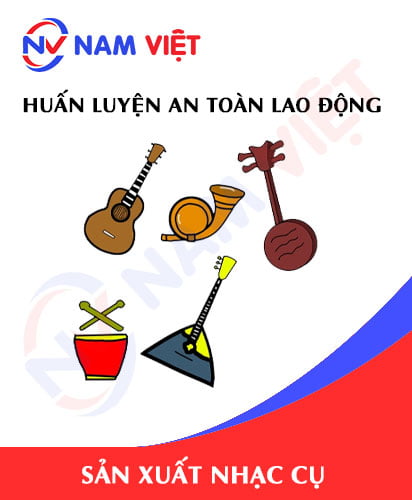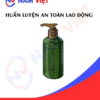Occupational Safety Training for Musical Instrument Manufacturing
99,000 ₫
Note: The above price is calculated per person and may vary depending on the number of participants in the course and market fluctuations. For more accurate pricing support, please refer to the price list or contact our consulting staff directly.
Occupational safety is an important issue in musical instrument manufacturing factories and needs to be addressed promptly to ensure the health and safety of workers and to enhance the reputation of businesses. The Occupational Safety Training course is one of the effective solutions to raise awareness of accident prevention for workers in musical instrument manufacturing.
Table of Contents
Toggle1. Overview of Musical Instruments
a. What are Musical Instruments?
- Musical instruments are tools and devices used to produce sounds and various melodies in music. Instruments can be simple tools such as whistles, gongs, horns, or more complex instruments such as pianos, guitars, drums, saxophones, etc.
- Each type of musical instrument has a unique sound and style, and they are used in various music genres such as classical music, jazz, pop, rock, and electronic music, etc.
- Musical instrument manufacturing factories in Vietnam offer good product quality and competitive prices, attracting attention and choice from customers both domestically and internationally. Additionally, musical instrument manufacturing also creates jobs for many workers and contributes to the country’s economic development.
- However, musical instrument manufacturing factories in Vietnam still face challenges such as competition from imported products and shortages of imported raw materials and components. To develop the musical instrument manufacturing industry in Vietnam, factories need effective business solutions, invest in improving product quality, and implement appropriate marketing strategies to reach domestic and international customers.

b. Machinery for Musical Instrument Manufacturing
The types of machinery and equipment used in musical instrument manufacturing depend on the type of instrument being produced. Some commonly used machinery includes:
- Wood saws: Used to cut wood into desired shapes and sizes.
- Polishing machines: Used to polish the surface of instrument parts to create smoothness and shine.
- Sanding machines: Used to sand instrument parts to remove cracks, scars, and create a smooth surface.
- Wire cutting and bending machines: Used for cutting and bending guitar strings and other stringed instruments.
- Grinding machines: Used to grind instrument parts to form precise curves and shapes.
- Laser engraving machines: Used to engrave images and letters on instrument surfaces.
- Press machines: Used to press layers of wood or other materials together to create strong instrument parts.
- Coating machines: Used to apply paint or protective coatings on instrument surfaces.
c. Notable Musical Instrument Manufacturing Factories in Vietnam
Some notable musical instrument factories in Vietnam include:
- Guitar Xuan Hoa brand: One of the largest guitar brands in Vietnam, with over 40 years of experience in manufacturing and distributing high-quality guitars. Guitar Xuan Hoa products are sold nationwide and exported to multiple countries.
- Tien Dung Musical Instrument Manufacturing and Trading Co., Ltd.: A leading manufacturer in Vietnam, specializing in guitars, bass, ukuleles, and other traditional instruments. Their products are exported to many international markets.
- Piano F.Kohler brand: A well-known piano brand in Vietnam, established in 1999, with over 20 years of manufacturing and distribution experience. Pianos are produced with modern technology and high quality.
- Dao Thi Hong Phuc Co., Ltd.: A reputable musical instrument manufacturer in Vietnam, specializing in guitars, ukuleles, moon lutes, dan tranh, and other traditional instruments. Products are recognized for high quality and reasonable pricing.
- Ha Thanh Musical Instrument Manufacturing and Trading Co., Ltd.: A major manufacturer in Hanoi, producing guitars, pianos, and other traditional instruments with high quality and reasonable pricing.

d. Specific Jobs in a Musical Instrument Manufacturing Factory
Group 1
- CEO, Deputy CEO, Department heads in the musical instrument manufacturing factory.
Group 2
- Safety officers: Manage safety in the factory, design safety procedures, supervise and ensure employees comply with safe work practices.
Group 3
- Part fabrication: Factories may have machines to fabricate parts of instruments, such as pieces of a guitar.
- Processing: After parts are fabricated, they are processed and finished to create a complete product.
- Painting and finishing: Once assembled, products are painted and finished to produce high-quality, aesthetically pleasing instruments.
- Quality inspection: Each product is inspected before being sent to retailers or customers.
- Maintenance and repair: Factories may provide maintenance and repair services for their instruments.
- Warehouse management: Factories manage storage to ensure products are stored and transported safely and efficiently.
Group 4
- Office, service, sales, and marketing roles.
- Production management, quality management, human resources management, materials management, finance and accounting management.
- Research and development of new products.
- Design and engineering: Manufacturers usually have teams of designers and engineers to develop new products and improve existing ones.

e. Popular Types of Musical Instruments
Some popular types of musical instruments include:
- Guitar: A widely used string instrument in modern music. Includes electric, classical, and acoustic guitars.
- Piano: A keyboard instrument used across many genres, from classical to pop and jazz.
- Drums: Percussion instruments used in rock, jazz, and other genres.
- Saxophone: A wind instrument used in jazz, pop, and other music genres.
- Violin: A string instrument used in classical, folk, and pop music.
- Harmonica: A wind instrument used in blues and folk music.
- Percussion instruments: Includes drum kits, custom percussion, and traditional percussion instruments from various countries.
These are just some of the common instruments; there are many more used worldwide.
2. Overview of Occupational Safety Training for Musical Instrument Manufacturing
This article focuses on Group 3, because Group 3 directly participates in the manufacturing process and faces the highest occupational safety risks. See other groups here.
a. What is Group 3 Occupational Safety Training?
- Group 3 occupational safety training consists of sessions that equip workers with awareness and methods to prevent workplace accidents.
- The training helps workers identify and avoid hazards, reducing the risks of occupational accidents during work.
REGISTER FOR OCCUPATIONAL SAFETY TRAINING SERVICE
b. Training Duration
Initial Safety Training Duration
- Total training time is at least 24 hours, including testing time.
- 8 hours of theory on safety policies, laws, and occupational hygiene
- 8 hours of theory on basic knowledge of safety and occupational hygiene
- 4 hours of theory on specialized training content
- 2 hours of practice on specialized training content
- 2 hours of final theoretical test
The occupational safety training center will divide the training into multiple sessions depending on worker scheduling. Typically, there are 6 sessions over 3 days, assuming the factory can schedule continuous learning time.
Periodic Safety Training Duration
- Before the occupational safety card expires, workers must undergo periodic occupational safety training, with periodic training duration of at least 50% of the initial training duration.
Explanation: The total duration of periodic occupational safety training is at least 12 hours, including testing time. After completing the periodic training and passing the test, the worker will have their occupational safety card reissued or extended.
c. Training Content
| No. | TRAINING CONTENT | TRAINING TIME (HOURS) | |||
| Total | Including | ||||
| Theory | Practice | Test | |||
| I | Safety policies and laws | 8 | 8 | 0 | 0 |
| 1 | Overview of regulations and legal framework on occupational safety and hygiene. | 6 | 6 | ||
| 2 | Standards and technical regulations on occupational safety and hygiene. | 1 | 1 | ||
| 3 | Specific regulations by state management agencies regarding safety when building, expanding, or renovating facilities and managing machinery, equipment, materials, and substances with strict safety requirements. | 1 | 1 | ||
| II | Basic knowledge of safety and hygiene | 8 | 8 | 0 | 0 |
| 1 | Basic knowledge of hazards and harmful factors in the workplace. | 4 | 4 | ||
| 2 | Methods to improve working conditions. | 1 | 1 | ||
| 3 | Safety culture in manufacturing and business. | 1 | 1 | ||
| 4 | Rights and duties of employers and workers; policies on occupational safety; roles of safety network personnel. | 1 | 1 | ||
| 5 | Safety rules, signs, guidance, use of safety equipment and personal protective equipment; first aid and occupational disease prevention skills. | 1 | 1 | ||
| III | Specialized training content | 6 | 4 | 2 | 0 |
| Comprehensive knowledge of machinery, equipment, hazardous substances; risk analysis and management; safe work procedures for machines, equipment, and substances with strict safety requirements. | 6 | 4 | 2 | ||
| IV | Final occupational safety test | 2 | 2 | 0 | 0 |
| Total | 24 | 22 | 2 | ||
See more training content of the 6 groups
d. Occupational Safety Card
After completing the training and passing the test, workers will be issued an occupational safety card (commonly called Group 3 safety certificate).
The Group 3 card includes personal information such as name, date of birth, job, and working environment. It also includes training duration, red stamp, and signature confirming course completion.
According to regulations stated in Clause 2 of Article 24 of Decree 44/2016/ND-CP, there are two cases:
- If the employer and worker have a labor contract, the employer must sign and stamp the safety card after the worker completes Group 3 training from an occupational safety training factory and passes the test.
- If the worker is freelance or seasonal, without a labor contract, the training unit must sign and stamp the card after the worker completes training and passes the test.

3. Identifying Hazards Affecting Workers in Musical Instrument Manufacturing
Some hazards affecting workers during musical instrument manufacturing may include:
- Musical instrument factories must use various types of machinery and equipment to produce their products. If not used properly, these devices can cause occupational accidents, injuries, and harm workers’ health.
- Employees in musical instrument factories often work in environments with high noise levels from machines and tools. This noise can damage workers’ hearing and reduce their concentration.
- The manufacturing process may involve chemicals for cleaning, polishing, or painting. These chemicals can be harmful to workers’ health if not used correctly or without proper protection.
- The paints and adhesives used in musical instrument manufacturing can release toxic fumes harmful to workers’ health.
- Workers may have to work in awkward positions or perform repetitive tasks for long periods, which can cause musculoskeletal injuries, muscle strain, or stress.
- In the musical instrument manufacturing environment, slippery surfaces or unstable materials may cause workers to slip, fall, or trip, which are hazards that need to be addressed and minimized.
4. Common Occupational Accidents in Musical Instrument Manufacturing
Common occupational accidents during musical instrument manufacturing may include:
- Vibration-related accidents: Tasks such as cutting, polishing, and milling may produce strong vibrations, causing injuries to workers’ hands, necks, and backs.
- Pressure-related accidents: Musical instrument manufacturing involves heavy machinery such as saws, milling machines, drills, etc. If safe working procedures are not followed, these devices can exert pressure on workers’ bodies, causing injuries.
- Fire and explosion risks: Manufacturing may involve flammable chemicals and materials. Failure to comply with safety regulations can lead to fire or explosion hazards, causing harm to workers.
- Accidents from unsafe equipment: Using equipment improperly or unsafely can also cause accidents during the manufacturing process.
- Chemical poisoning: Using chemicals in manufacturing may expose workers to toxic risks. Common chemicals like formaldehyde, paints, detergents, and cleaning agents can cause skin irritation, respiratory problems, or headaches if not used properly or without protective measures.
5. Safety Measures When Participating in Musical Instrument Manufacturing
Safety measures in musical instrument manufacturing include:
- Use of protective equipment: Employees should be provided with helmets, safety glasses, chemical-resistant sleeves, gloves, safety shoes, and masks to protect their eyes, ears, nose, mouth, and skin from harmful substances, dust, and noise.
- Safety training and guidance: Employees should be trained and guided on safe working procedures, use of protective equipment, and potential hazards in the manufacturing process.
- Safety supervision: Factories should have safety supervisors to monitor compliance with safety procedures and address any safety issues immediately.
- Safe working conditions: Employees should have safe working conditions, including proper temperature, humidity, ventilation, lighting, and appropriate safety equipment.
- Equipment maintenance and inspection: Manufacturing equipment should be regularly maintained and inspected to ensure proper operation and minimize accident risks.
- Chemical management: Chemicals used in manufacturing should be properly stored, transported, and used to avoid harm to employees.
- Proper waste classification and disposal: Waste generated during manufacturing should be classified and disposed of correctly to minimize negative impacts on the environment and human health.
- Periodically conduct occupational environment monitoring in factories to collect and analyze harmful factors, then adjust to reduce hazards and prevent occupational diseases.

6. Benefits of Occupational Safety Training in Musical Instrument Manufacturing
An Toan Nam Viet provides businesses with the following benefits after completing occupational safety training in accordance with Decree 44/2016/NĐ – CP on occupational safety and hygiene:
- Workers can recognize potential hazards and take preventive measures to avoid occupational accidents.
- Businesses can establish risk prevention measures in production, operation, and maintenance processes.
- Reduce costs associated with occupational hazards.
- Continuous production improves labor productivity and product quality.
- Compliance with occupational safety laws avoids legal risks.
- Enhances credibility and professionalism, boosting the company’s brand.
An Toan Nam Viet’s training courses are a solution to prevent external hazards, helping individuals avoid injuries or more severe consequences.
REGISTER FOR OCCUPATIONAL SAFETY TRAINING
7. Customer Feedback After Completing Musical Instrument Manufacturing Safety Training
An Toan Nam Viet has many years of experience accompanying enterprises in Vietnam, especially in the southern provinces. Our commitment is highly valued, which is why our occupational safety training is increasingly professional. The growth of An Toan Nam Viet comes from positive feedback and suggestions from our clients. Below are testimonials from partners we have served.
See more customer interviews after using An Toan Nam Viet services
8. Occupational Safety Training Capacity of An Toan Nam Viet
An Toan Nam Viet is a reputable and high-quality occupational safety training center in Vietnam. Our safety training sessions are continuously conducted at factories, manufacturing workshops, or construction sites across all 63 provinces.
REGISTER FOR OCCUPATIONAL SAFETY TRAINING
Occupational Safety Training License
- An Toan Nam Viet has been inspected and certified by the Department of Safety of the Ministry of Labor – Invalids and Social Affairs, granting the certification for occupational safety and hygiene training. This further strengthens our occupational safety training capacity.

Training Materials and Lectures
- Before being included in our occupational safety training courses, materials are carefully reviewed to ensure accuracy and practical effectiveness.
- Our instructors’ teaching methods are standardized according to An Toan Nam Viet guidelines, developed by experts in occupational safety and hygiene training to maximize knowledge absorption for trainees.
Facilities
- Control of classroom conditions impacts training efficiency and knowledge retention.
- Our training facilities provide spacious classrooms with proper lighting, equipment, and training tools.
9. Nationwide Reputable and Quality Occupational Safety Training Center
At An Toan Nam Viet, professional dedication in occupational safety training is our top priority. Our mission is to teach workers to protect themselves and equip them with safety knowledge, contributing to national development.
To ensure effective training, we meticulously prepare every detail, from tools and equipment to curriculum, materials, audio, and lighting.
Our instructors are experienced experts, some with research on hazard identification across industries and prevention methods.
Lectures are practical, engaging, and easy to understand, helping trainees comfortably absorb knowledge. All content strictly follows Decree 44/2016/ND-CP.
Trainees learn multiple preventive measures and how to protect themselves, applying them appropriately in real work situations.
Our training center proudly provides professional and reliable occupational safety training with advantages:
- Competitive training costs without compromising quality.
- Flexible training schedules aligned with enterprise production.
- Fast certification procedures compliant with legal regulations.
- Experienced and professional instructors.
- Controlled classroom environment to enhance teaching efficiency and knowledge absorption.
- Curricula tailored to enterprise occupational safety needs.
- An Toan Nam Viet works diligently and professionally to provide accurate and rapid support to clients.

10. Additional References for Musical Instrument Manufacturing Occupational Safety Training
- Musical Instrument Manufacturing Occupational Safety Materials
- Occupational Safety Training Materials
- Occupational Safety Training Test Bank
- Musical Instrument Manufacturing Occupational Safety Quiz
- Musical Instrument Manufacturing Occupational Safety Training Slides
1 review for Occupational Safety Training for Musical Instrument Manufacturing
No comments yet















namchinh.haiphong341
Dịch vụ ở đây tốt nhé!